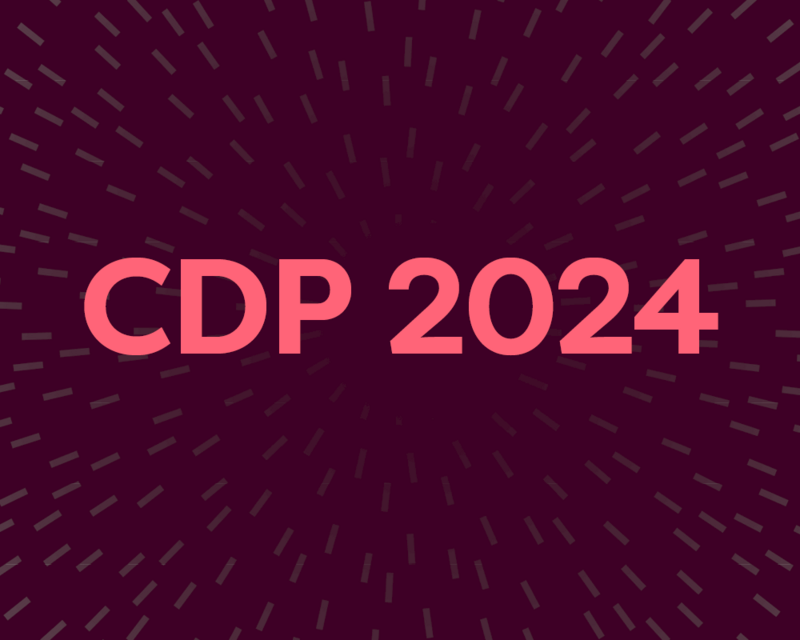CDP’s streamlined disclosures for 2024 – what’s new?

The CDP reporting window is now open and runs until 2nd October, with the scoring deadline of 18th September. Verco's Esther Stoakes, Principal Consultant and climate disclosure specialist, summarises the main changes to this year’s CDP questionnaire and answers common questions.
What are the main changes to CDP for 2024?
The main changes to the CDP questionnaire for 2024 include an integrated questionnaire, a new software platform, and alignments with IFRS S2 / ISSB standards. The CDP is also working towards aligning with TCFD and ESRS plus SEC climate disclosure rules. To achieve this, the CDP is incorporating the Dependencies, Impacts, Risks and Opportunities approach of the Taskforce on Nature-related Financial Disclosures (TNFD). Additionally, there are changes to the forests questionnaire and scoring methodology, as well as some changes to which companies will be asked to respond to in terms of environmental themes. Scoring methodologies will remain broadly the same but scoring levels below leadership will now have essential criteria to meet to gain management or awareness scores.
What are the key CDP dates for 2024?
Questionnaires were published at the end of April, and the reporting window runs from 4th June to 2 October with the scoring deadline of 18 September.
What does the CDP integrated questionnaire mean?
Companies responding will see one questionnaire only when they log into the platform. Information still needs to be disclosed on the separate environmental themes of climate change, forests and water plus plastics and biodiversity.
Similar information is grouped together in common modules and questions, some of which will be integrated across all environmental themes. Environmental information may be disclosed within integrated questions, disclosing how it applies to each theme in turn, or in separate rows in a table format, or choosing relevant drop-down options.
Specific environmental data, for instance on GHG emissions reporting, water use, forest commodities information will be in questions in separate modules, within this single questionnaire.
There will still be separate environmental scores for Climate, Water and Forests and plastics and biodiversity will not be scored.
What are the CDP forests changes in 2024?
There will no longer separate scores for different commodities (palm oil, soy, cattle and timber) but a single forests score. The commodity element of the scoring will be weighted by the volume of commodity used, produced or sourced. For example, if a company sourced the same volumes of soy and palm oil, the scoring would be apply a weighting of 50% on disclosures related to each. Companies are expected to disclose on all commodities they source or produce.
The forests questionnaire does not apply just to deforestation but to any land use change and conversion of other ecosystems.
What are the new CDP 2024 Climate Change A-list criteria?
In order to achieve the highest CDP Climate Change score of A, companies will need to have a high percentage score over the thresholds to be released by CDP later. (Likely over at least 70%) In addition, the following actions must be disclosed;
- 100% of Scope 1 and 2 Emissions >70% of at least one category of Scope 3 emissions verified.
Service guide: Scope 3 verification
- A near-term emissions reduction target aligned with 1.5 degrees scenario and /or validated by the SBTi in place (plus portfolio targets for financial services companies).
Service guide: Net zero targets
- A publicly available 1.5 degree aligned climate transition plan, overseen by the board, implemented by management, with progress tracked.
Service guide: Transition plans
- Board remuneration is linked to reported environmental performance metrics.
- Public policy engagement follow a policy of keeping it aligned with the Paris agreement.
- Engages with suppliers on climate change.
- No relevant emissions excluded from the reporting boundary.
- Disclosure of relevant fuel consumption and/or energy generation.
Service guide: Metering, tracking and verification - Scopes 1 & 2
- Additional criteria must be met for certain sectors with a high climate impact
In addition, CDP has introduced essential criteria to achieve awareness, management and leadership scoring levels, beyond simply exceeding scoring thesholds. The full list of criteria is available in CDPs “Scoring essential criteria” document, which can be downloaded from the CDP website.
How can I assess Dependencies, Impacts, Risks and Opportunities for the CDP questionnaire?
The concept of Dependencies, Impacts, Risks and Opportunities is taken from the Taskforce on Nature related Financial Disclosures. The TNFD framework is freely available online with significant supporting guidance, so companies are advised to refer to this resource, and specifically the LEAP framework developed by TNFD. Companies may also be able to build on their existing environmental risk assessment processes, location-specific water risk assessments, commodity sourcing mapping, double materiality assessments or climate scenario analysis to inform this assessment.
Does the 2024 CDP questionnaire help companies prepare for mandatory disclosures?
Yes, the CDP 2024 changes are consistent with current trends in sustainability reporting which move towards a systemic approach, with environmental issues increasingly integrated together and into business management, governance and operating systems. This is necessary to be able to take effective long-term action, because different environmental issues are inherently interconnected; as in fact are business issues. The new standards support sustainability leads to make the business case for a strategic response to environmental issues facing companies.
European CSRD regulations and international IFRS/ISSB disclosure standards are pushing beyond climate and environment to a broader sustainability focus. These standards mark an evolution of integrated reporting because there are now detailed and specific standards which spell out expectations and good practice. While it can be challenging to collect additional data points, companies benefit from greater clarity around what they should disclose. As these standards roll out, responding to the CDP questions aligned with these frameworks will help companies prepare for mandatory disclosures by starting with a voluntary approach.
We're at a moment where principles-based and rules-based approaches to sustainability reporting are meeting: overarching principles-based approaches act as a sense check and stop bad-faith "gaming" but rules provide clarity for reporters and enable comparable data. This will allow better, smarter use by stakeholders and drive a virtuous cycle of raised expectations.
Case study: Atlantic Packaging achieves a CDP A-list
Verco CDP services
Verco has supported companies from a range of sectors with CDP their disclosures for over a decade, from full support in completing the questionnaires through to rapid reviews of draft responses and scoring assessments. If you are interested in discussing how Verco can help you respond to CDP, please get in touch with us via the link below.
